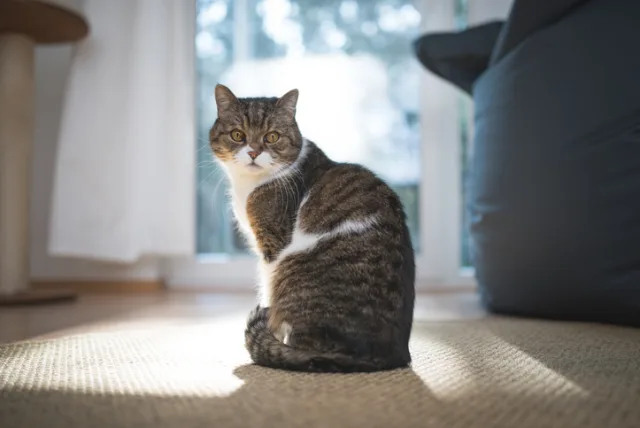
Teddy, an 11-year-old neutered male domestic shorthair cat, is presented for a stiff gait, reluctance to jump, and trouble posturing to defecate. Clinical signs have developed over the past 3 to 6 months. Teddy has a history of International Renal Interest Society (IRIS) stage 2 chronic kidney disease (CKD) with mild proteinuria (urine protein:creatinine [UPC] ratio, 0.8) and moderate hypertension. He is currently receiving amlodipine (1.25 mg PO every 24 hours) and benazepril (2.5 mg PO every 12 hours) and is fed a dry prescription kidney diet.
On physical examination, BCS is 4/9, there is mild muscle loss that is more pronounced in the pelvic limbs, heart rate is 180 bpm with no murmur, blood pressure is 142 mm Hg, and the colon is moderately full of compressible stool. Pelvic limbs have palpable pulses and are warm to the touch. There is no ataxia and no evidence of a plantigrade stance. Paw replacement is intact, and patellar reflexes are normal. Teddy vocalizes on extension of both hips, which demonstrate palpable bilateral crepitus.
Abdominal/pelvic radiographs show osteophytosis and increased subchondral bone opacity in both hips (moderate degenerative joint disease), with stool filling the transverse and descending colon. The pelvic inlet is of normal diameter.
Blood glucose, serum potassium, and serum calcium are normal. Serum creatinine is 2.6 mg/dL (stable; reference interval, 0.8-2.2 mg/dL). UPC ratio is 0.2 (normal), and urine specific gravity is 1.018.
There is concern for decreased renal perfusion in geriatric cats with CKD. Teddy is receiving an ACE inhibitor. ACE inhibitors and angiotensin receptor blockers (eg, telmisartan) can further impair the kidneys’ compensatory response to poor renal perfusion.